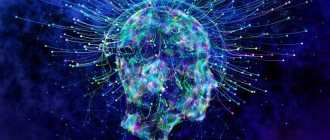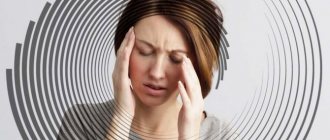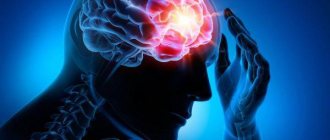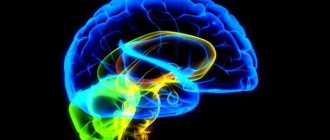Consciousness is the ability to perceive oneself and the external world, as well as to report on events occurring in the external world and form one’s own reaction in response to these events.
Consciousness allows you to navigate the environment, time and your own personality. The formation of human consciousness occurs in several stages:
- Waking consciousness . The presence of such consciousness allows you to choose the most favorable environment for yourself. So, a child under 1 year old understands that he is more comfortable in his mother’s arms than just on the soft surface of the crib;
- Subject consciousness . Such consciousness is typical for the ages of 1-3 years, it allows the formation of a basic idea of objects - “cat”, “dog”, “grandfather”, “grandmother” and others;
- Individual consciousness . This type of consciousness is formed in the period from 3 to 9 years. The child receives basic ideas about space and time, and, thanks to this, distinguishes himself from the environment;
- Collective consciousness . In the period from 9 to 16 years, a teenager develops a collective consciousness that combines a basic idea of himself with a basic idea of other people and builds initial interpersonal interactions;
- Reflective consciousness . This is the most mature form of consciousness, it is formed from 16-22 years old and onwards. Such consciousness allows for introspection and deep analysis of the world around us, establishing complex cause-and-effect relationships and making predictions for the future.
Pathologies of consciousness are a very important branch of neuroscience. Every doctor must be able to determine the degree of lucidity of the patient, because many emergency conditions are very closely related to disturbances of consciousness. Universal criteria that allow one to suspect disorders of consciousness were proposed by the German psychiatrist Karl Jaspers . These criteria are the basic diagnostic tool to this day:
- Detachment from the outside world;
- Disorientation in time, space and self;
- Thinking disorders;
- Amnesia.
Let's look at them separately, this is a fundamentally important point.
Detachment from the outside world means a state in which the patient does not perceive (does not fully perceive) everything that happens around him. It is always difficult to establish contact with such a patient; he does not hear or perceive speech addressed to him, he ignores the gestures and facial expressions of the interlocutor with normally functioning organs of vision and hearing. In order to get an answer from the patient, the doctor has to repeat the question very loudly and several times. Often contact with such patients is generally impossible. Detachment is the main criterion for clouding of consciousness.
Disorientation is a lack of understanding and/or misconception. As you remember, within the framework of our symptom complex, disorientation in time, space and one’s own personality is distinguished. Time disorientation is a condition in which the patient ceases to understand what time of day it is, what day of the week, month or even year. As a rule, the first symptom of clouding of consciousness is disorientation in time.
Disorientation in space is the patient’s lack of understanding of where he is now. A person in a hospital may believe that he is in a store, office center or stadium. Disorientation in space and time is classified as allopsychic disorientation.
The most severe mental disorders are accompanied by disorientation in one's own personality . It is also called “autopsychic disorientation.” During personality disorientation, the patient experiences difficulty in self-identification - he cannot say who he is, what he does and what his name is. Also, such disorientation manifests itself in situations when the patient begins to perceive himself pervertedly - he may consider himself a supernatural being, a demon, an alien from another world, an animal, an inanimate object or phenomenon - a black hole, a magical amulet.
Thinking disorders during disorders of consciousness are manifested by a variety of symptoms. The most common is fragmented thinking, which turns into incoherence. This is expressed, as you remember, in the patient’s speech, which becomes similar to the pronunciation of individual words and interjections that are in no way connected with each other.
Amnesia is a complete loss of memory of any period. In the case of disorders of consciousness, we are talking about loss of memory of the period of the illness itself. If we are talking about a mild disorder, the patient may remember some events that occurred during the illness, but without any details and with a broken sequence.
Impairments of consciousness are also divided into qualitative and quantitative.
Quantitative disorders of consciousness
Quantitative disorders of consciousness include conditions in which consciousness, without being distorted, fades more and more depending on the pathology. In this list, I will arrange quantitative disorders of consciousness in exactly this way - from the state with the least loss of consciousness to the state when it is completely absent:
- Stun
- Sopor
- Coma
In a state of stunning, the patient has an increase in the threshold of perception of all analyzers. That is, he does not perceive normal speech, it needs to be louder. Even very loudly and clearly spoken phrases will be understood by the patient only if they are simple and monosyllabic. The patient will not react at all to any intricate phrases or narration. Visually, he perceives only very sharp changes in the image or situation - if, for example, a chair or armchair is placed directly in front of him, the patient will not react in any way. The patient will also not pay any attention to mild physical impacts; only slight movements of the eyelids are possible in the case of, for example, an unsuccessful and extremely painful injection.
A patient in a state of stupor, as a rule, understands that he is in a hospital, but there are always problems with further orientation - he cannot say which hospital he is in, what time it is and in which department he was placed.
There are also separate types of stunning - obnubilation and somnolence. Numbulation is a mild degree of stunning, in which the patient occasionally gets out of bed and walks around the ward, but detachment from everything around him is clearly noticeable. Somnolence is a stupor in which the patient always wants to lie down and sleep. If he is awakened, he will be able to answer a few simple questions, but after the end of the conversation he immediately falls asleep, regardless of the presence of noise or other stimuli.
Stupor is a much more severe disturbance of consciousness, in which the patient gives the impression of being deeply asleep. Mental activity in this state completely stops. It is impossible to completely awaken or in any way rouse such a patient. Sometimes it is possible to produce subtle responses, such as opening the eyes slightly in response to a very loud speech next to the ear or a dull groan in response to the infliction of very severe pain.
Most of the simplest reflexes (tendon, skin) may be suppressed, but not absent - this is often what distinguishes stupor from coma. Therefore, stupor is also called “precoma.” When leaving the state of stupor, a person will not remember anything from the period of illness.
Coma is the most severe quantitative disorder of consciousness. In other words, it is a complete lack of consciousness. A patient in a coma lies motionless; a response on his part cannot be evoked by any irritants. There are no unconditioned reflexes, except for the pupillary and corneal (corneal) ones.
Qualitative disturbances of consciousness
You are probably already accustomed to this simple classification of pathologies of mental functions in psychiatry. Almost all violations of all functions are divided into quantitative (strengthening and weakening) and qualitative (perversion). Today’s topic will be no exception - qualitative disorders of consciousness are a perverted version of normal consciousness, not reduced quantitatively.
The main qualitative disorders of consciousness are delirium, amentia, twilight stupor and oneiroid.
Delirium
Delirium is a severe disturbance of mental activity, which is expressed in confusion, true hallucinations, illusions, severe psychomotor agitation and disturbance of orientation in place, time and (sometimes) in personality.
Delirium begins with a feeling of anxiety, restlessness and increased sensitivity to light, sounds and other stimuli (hyperesthesia). The patient suffers from insomnia, trying in vain to relax and fall asleep. Then anxiety increases, reaching panic. At the same time, perception disorders appear - first illusions, and then hallucinations. Illusions in this state are closely related to the surrounding environment - the glare of light from street lamps forms ominous human faces, the branches of a house plant become hooked paws, and the patterns on the carpet turn into streams of running insects.
Then mental disorders increase, and hallucinations join the general fun. In the overwhelming majority of cases, these are true frightening hallucinations - patients see rotting impersonal corpses, blood, dead relatives, hostile supernatural beings.
At the peak of delirium, scene-like hallucinations appear, that is, the entire situation changes - patients, while in the hospital, see themselves in a cemetery, in their own crypt, on board a spaceship, in the bowels of another planet, etc. The patient experiences extreme fear or rage, he tries to interact with the hallucinations - to hit them, push them away, or flee. In this state, patients show extraordinary strength, they destroy furniture and overturn heavy objects, they can jump out of a window, without realizing that they are putting their lives at risk.
The patient cannot sleep until the delirium resolves. Typically, the state of delirium lasts 2-4 days, after which the patient falls soundly asleep and, after half a day of deep sleep, wakes up in a normal mental state.
In modern psychiatry, special types of delirium are distinguished:
- Abortive delirium . Such delirium resolves within a few hours, orientation is only partially impaired, and proceeds relatively easily;
- Delirious delirium . The more common term is “muttering delirium.” This type of delirium is characterized by a more profound impairment of consciousness. Here there is chaotic excitement within the bed, indistinct muttering and shouting of individual words or fragments of phrases. There are senseless grasping movements;
- Occupational delirium is a condition similar to ordinary delirium, however, with all other similar symptoms, the patient is convinced that he is at his workplace and performs stereotypical actions related to his work (hammering non-existent nails, signing non-existent contracts, etc.).
A fundamentally important point is that with delirium, orientation in one’s own personality is not disturbed Interaction with hallucinations occurs in accordance with the patient’s temperament - brave and courageous people rush in rage at “demons” or “living dead”, while more cautious people run away in horror or try to hide.
Amentia
Amentia is a clouding of consciousness, very similar to ordinary delirium. However, with amentia, the patient does not leave the bed; periods of excitement alternate with periods of complete rest (amnestic lacunae). His thinking is incoherent, and his speech consists of separate words.
With amentia, orientation in the individual is disrupted. Patients are not available for contact. Also, with amentia, hallucinations, unlike delirium, are scanty and ephemeral. An important feature of amentia is severe physical exhaustion . As a rule, amentia indicates a long-term debilitating disease.
Twilight stupefaction
Twilight stupefaction (twilight state) is a sudden, deep disorientation in the surrounding space while maintaining the usual automatic actions. Here we are talking about a condition when a “failure” in consciousness suddenly occurs and the patient completely ceases to control and feel himself. I remember the story of my propaedeutics teacher about one of his patients.
This was a young woman who, for the first time in her life, experienced an attack of twilight stupefaction. She came home after a long day of work, closed the door behind her and lost consciousness before she had time to take off her coat and hat (it was late autumn). When she woke up, this young woman experienced a chilling horror, because when she opened her eyes, she saw that she was standing in front of the mirror in an evening dress and with bright makeup.
There is a triad of signs characteristic of the twilight state:
- Paroxysmality is a sudden onset and an equally sudden end;
- The behavior of patients is determined by the nature of their experiences;
- Complete amnesia for the entire painful period.
Clinically, two large groups of states of twilight consciousness are distinguished: ambulatory automatism and delusional-hallucinatory (sometimes separately delusional and hallucinatory) twilight consciousness.
Outpatient automatism
Outpatient automatisms are short periods of confusion during which the patient performs habitual, automatic actions. There is no violent behavior or socially dangerous acts here. Being in a state of darkened consciousness, “oblivion,” patients can move around the streets, stop in front of a red traffic light, and briefly answer questions from others. After the end of the attack of twilight consciousness, the patient does not understand how he ended up in this or that place, and does not remember his words and actions at all. I considered a typical example of ambulatory automatism a little higher, when we were talking about a young girl who suddenly found herself in a dress. Outpatient automatisms are classified into fugues, trances and somnambulism.
Fugues (from the Latin “fugas” - “to run”) are sharp, short-term attacks of stupefaction, during which the patient, unexpectedly for those around him, breaks away and rushes to run in bizarre directions, which he himself, after emerging from the attack, cannot explain. The fugue lasts, as a rule, no more than 2-5 minutes.
Trances are states in which the stupefaction of consciousness lasts longer than during fugues. During trance, the patient can leave the house, use public transport, or even leave the boundaries of his city. When the attack passes, the patient finds himself disoriented in an unfamiliar place and has no idea how he got there.
Somnambulism is exactly what our grandparents called “sleepwalking.” Attacks of somnambulism occur during sleep. The patient, in the presence of a minor irritant (the light of the moon or a night lamp), gets out of bed, performs automatic actions - walks, straightens the bed, overcomes obstacles, after which he returns to bed and continues the interrupted sleep. The next morning the patient does not remember anything from the night's incident and listens with surprise to stories about his attack.
There are a number of recommendations for patients suffering from somnambulism - when choosing real estate, choose apartments located on the ground floor, do not store cold and loaded firearms at home, and, if possible, install alarms on the doors.
World of Psychology
to the Table of Contents
Chapter 4. The structure of consciousness
States of consciousness
Traditionally, psychology recognizes two states of consciousness inherent in all people: 1) sleep, considered as a period of rest, 2) a state of wakefulness, or an active state of consciousness, which corresponds to the activation of the whole organism, which allows it to capture, analyze signals from the outside world, and send some of them into memory or to respond to them with adequate or inappropriate behavior depending on previous experience and skills. Thus, wakefulness is the state in which we can adapt to the external world. The way we are aware of the outer world and at the same time our inner world changes throughout the day depending on our state - whether we are tense or not, excited or half asleep. Thus, information processing changes very significantly depending on the level of wakefulness. According to the Yerkes-Dodeon-Hebb law, a person’s behavior will be more effective the closer his level of wakefulness—activation—is to a certain optimum—it should be neither too low nor too high. At lower levels, a person's readiness to act decreases, and he soon falls asleep, and at higher levels, he will be more agitated due to too strong motivation or a strong disturbance of feelings, and his behavior may even become completely disorganized.
On average, our body functions with an alternation of 16 hours of wakefulness and 8 hours of sleep. This 24-hour cycle is controlled by an internal control mechanism called the biological clock, which is responsible for activating the sleep center located in the brain stem and the wakefulness center in the reticular formation of the brain. For a long time it was believed that sleep is simply complete rest for the body, allowing it to restore the strength expended during wakefulness. Thus, lack of sleep significantly affects behavior: mental and work activity worsens or is even disrupted; some people literally fall asleep while standing, hallucinate or begin to delirium after two or three days of sleep deprivation. It is now known that sleep is not just a recovery period for the body, it has different stages and performs various functions. There are “slow-wave sleep” and “rapid, paradoxical sleep” depending on the characteristics of brain activity. The brain consists of more than 10 billion cells, and each of them is a miniature station capable of creating an electrical potential when excited. Since 1924 The electrical activity of the brain began to be recorded in the form of an electroencephalogram (EEG) using electrodes attached to the human scalp. Electrical potentials in the brain are displayed graphically as waves recorded on a moving strip of paper. When brain activity is low, large groups of nerve cells discharge simultaneously, and this synchrony is reflected on the EEG in the form of waves of low frequency and high amplitude - “slow waves”:
- alpha waves, the frequency of which ranges from 8 to 12 cycles per second (8-12 Hz), they are characteristic of a relaxed body, when a person sits quietly with his eyes closed;
- theta waves with a frequency of 4 to 7 Hz, they appear in the first stage of sleep,
- delta waves (0.5-3 Hz), which are recorded during deep sleep.
During active brain activity, each participating nerve cell discharges in accordance with its specific function in its own rhythm, as a result, brain activity becomes asynchronous and is recorded in the form of fast waves of high frequency and low amplitude - beta waves (13-26 Hz) ; The amplitude of beta waves decreases as brain activity increases.
Rice. 4.4 Graphic expression of the Yerkes-Dodson-Hebb law
Beta waves are recorded during wakefulness, active mental and physical activity, and also, oddly enough, during REM sleep. “Rapid wave sleep” is characterized by the fact that brain activity increases, as if a person is waking up, the heart rate accelerates, blood rushes to the brain, breathing quickens, the eyes make rapid movements under closed eyelids, but at the same time the person is completely immobile due to a sharp drop in muscle tone. This stage of “rapid, paradoxical sleep” lasts 15-20 minutes, it is difficult to wake a person at this moment, but if this is possible, then in 80% of cases he says that he had a dream and can tell it in detail. After “REM sleep”, “slow sleep” occurs again, then, after about 70 minutes, “REM sleep” again, and this cycle is repeated 5-6 times per night. The alternation of these phases and normal sleep duration (6-8 hours) are mandatory conditions for human health. However, there are cases where people do not sleep at all. Studies have shown that those who do not sleep actually have fractional sleep, lasting only a few seconds during every minute, i.e. they sleep sporadically throughout the 24 hours of the day. Such fractional sleep excludes certain types of information processing during sleep and is an evolutionary regression (it is known that such fractional sleep, for example, is common for wolves).
According to Hartman's hypothesis (1978), disconnecting a person from the external environment during sleep is necessary for meaningful processing of information accumulated during the day.
During the period of night sleep, Information in small portions comes from intermediate memory to short-term memory, which is disconnected from the external environment for this purpose. Each portion is processed sequentially in two phases: the first phase is the logical processing of information, compared with the “slow sleep” phase. Here the Information is evaluated and summarized. The second phase - processed Information is sent to certain parts of the long-term memory structure, where it is associated with the material stored there, which is accompanied by dreams in the REM sleep phase. If you wake up subjects in the slow-wave sleep phase and ask if they had a dream, then 80% will have a negative answer, but subjects can indicate that logical constructions arose, thinking through situations directly related to the real events of the past day. In the slow phase there are no eye movements, but motor activity of a different kind is observed: sleepwalking (sleepwalking) and sleep-talking, when a person gets out of bed and, without waking up, is able to walk around the house, answer questions that are asked to him, but after waking up he does not remember anything about your nightly adventures. It was found that with a high load on the visual analyzer in a person, slow-wave sleep is prolonged; this confirms the participation of slow-wave sleep in the processes of processing information received during wakefulness.
Research has shown that a certain area of the reticular formation of the brain is responsible for the REM sleep phase, consisting of giant cells, the branches of which extend far into neighboring areas and lead to the activation of sensory areas of the brain, especially the visual zones, and excite the higher brain centers of drives and emotions. And dreams that occur in the REM sleep phase are the result of the synthesis carried out by the cerebral cortex of those signals that come from various areas of the brain activated during paradoxical sleep. dreams reflect the motivation and desires of a person; these motivations seem to emerge during sleep, when the cells of the reticular formation send exciting impulses to the centers responsible for drives and instincts. dreams serve, as it were, for the symbolic realization of a person’s unfulfilled desires, they discharge pockets of excitement that have arisen due to unfinished business and disturbing thoughts. According to Freud, dreams provide psychological comfort by reducing the emotional tension that arises during the day and thereby causing a feeling of satisfaction and relief.
Research by Fowlkes (1971) showed that a child's frequency of anxious dreams is proportional to the number of difficulties he encounters while awake. The same can be said about adults, i.e. dreams, intensive brain work during sleep, are intended to help a person solve his problems during sleep or to weaken or even eliminate a desire or experience that worries a person. This idea is consistent with the position of Plato, who wrote that good people are content with dreams of what bad people actually do. dreams arise as a result of a conflict between repressed experiences and vigilant control of consciousness, which takes on the character of “censorship.” During the period of night sleep, control weakens, but not so much that unacceptable motives and desires can be recognized in their true form, and then these “repressed desires” are masked in dream images that are incomprehensible to consciousness - and thus bypass “censorship.” According to Freud, it is enough to interpret the elements of dreams as certain symbols in order to come to an understanding of the drives and conflicts repressed into the unconscious. The penetration of transformed motives into consciousness through dreams leads to partial relief of emotional stress and mental balancing of a person. According to French and Fromm's hypothesis, dreams use the mechanisms of imaginative thinking to resolve motivational conflicts that cannot be resolved with the help of logical analysis during wakefulness, i.e. dreams represent a mechanism of psychological protection and stabilization of a person, thanks to which a person draws the energy necessary to resolve his problems. dreams are a kind of “window” into a person’s unconscious and a kind of “channel” for the exchange of information between the unconscious and consciousness, when a more information-rich “unconscious” is capable of conveying important information to consciousness in a symbolic or explicit form (for example, prophetic dreams about future possible events, about emerging diseases, internal mental pain points, etc.).
Meditation is a special state of consciousness, changed at the request of a person. All types of meditation have one goal - to focus attention in order to limit the field of one's consciousness so much that the brain will react rhythmically to the stimulus on which the person is focused. There are several ways to achieve this goal: you can focus on thoughts or physical sensations, as do the followers of “zazena,” or you can practice yoga, which emphasizes mastery of bodily postures and breathing. In all cases, the brain begins to synchronize its electrical activity more and more - most often of the alpha wave type, and sometimes theta waves. Transcendental meditation is based on the use of a special word - mantra. The mantra, usually chosen by the “teacher” for the student, consists of sounds such as O, M, N, U, which easily resonate with the electrical activity of the brain. A person, sitting comfortably or lying in a quiet, not too lit place, closing his eyes and breathing deeply through his nose, pronounces the mantra with each breath, first loudly, then more quietly and more quietly, thinking only about the word that comes out of his lips, and about nothing friend. If you want to get even closer to the Eastern technique, choose a mantra that matches your age group: from 16 to 18 years old - EMA; from 18 to 20 years old - ING; from 20 to 22 years old - OM, etc. The mantra is pronounced first out loud and then silently until the person reaches a state of complete relaxation and “pure consciousness”, from which all events and perceptions of the external world are excluded and which, according to adherents, borders on a sense of eternity.
Pathological states of consciousness are caused by drugs and other chemicals that affect the brain. These psychotropic substances can speed up the transmission of sensory signals, or block or modify it, or prevent certain nerve centers from performing their functions normally. With repeated use, these substances cause physical and psychological dependence, when a person can no longer exist without these substances. Physical dependence occurs due to the fact that drugs affect the brain's neurotransmitters (these are substances responsible for transmitting nerve signals from one neuron to another at synapses), causing such a change in the functioning of neurotransmitters that the body cannot do without the drug, and if you stop its introduction immediately, then withdrawal syndrome occurs, sometimes with fatal outcome. Psychological dependence is expressed in the desire to use a drug for the pleasure or feeling of satisfaction that it provides. The use of psychotropic substances leads to the development of tolerance: the body becomes resistant to their effects, and increasingly larger doses are required to achieve the desired effect, but an overdose often leads to death.
Let us consider the features of those substances that can influence the human condition. Many people, without realizing it, use psychotropic substances every day to “stimulate” themselves, to get involved in the work day: this is primarily caffeine contained in coffee, tea, and tonic drinks like Coca-Cola. It is a weak stimulant.
Nicotine is another stimulant, but not so harmless. Nicotine, by enhancing the secretion of serotonin, weakens the activity of brain cells, which leads to a feeling of peace and calm, but after a while there is an increase in norepinephrine, and this is accompanied by an increase in brain activity; however, this effect lasts only a few tens of minutes, and then the smoker wants to start all over again. It becomes clear how difficult it is to get rid of this unhealthy habit, not to mention the psychological dependence.
Amphetamines are much more stimulating substances; they cause a significant increase in the concentration of nor-adrenaline, which creates a state of general excitement, a feeling of physical well-being, self-confidence, a state of intellectual exaltation, an irresistible desire to speak, create, but then a breakdown occurs. Long-term use of amphetamines leads to paranoid manifestations: a person begins to feel harassed, the slightest movement of another person can be perceived as a threat, delusional thoughts, auditory hallucinations, etc. arise.
Cocaine is an stimulant that causes a state of euphoria, when a person feels an excess of strength, confidence, and activity, but this state is quickly replaced by anxiety and unpleasant auditory hallucinations. Cocaine quickly causes psychological and later physical dependence.
Neurodepressants have the opposite effect - they inhibit the activity of brain centers, reduce the supply of oxygen to the brain, which leads to weakening of brain activity - this leads to poor coordination of movements, confused speech, blurred thinking, and loss of attention. Many people do not know that alcohol is a neurodepressant, although its initial effect after one glass of wine excites a person, the person becomes noisy, excited, freed from some internal inhibitions and is able to perform unexpected actions. However, the more a person drinks, the more the activity of his body decreases, coordination of movements and speech is impaired, the ability to think logically and make the right decisions decreases, even to the point of insanity. Alcohol abuse also leads to irreversible changes in the body, causing blood clotting, which clogs the blood capillaries, causing them to burst: this explains the red color of the nose in alcoholics, as well as the destruction of brain cells that do not receive enough oxygen from the blood. Alcohol can cause psychological and physical dependence if consumed frequently.
Sleeping pills (barbiturates) inhibit brain activity, induce sleep, but disrupt the REM sleep phase; in cases of substance abuse (poisoning), memory impairment, weakening of mental activity, and loss of interest in work and life are possible. In large doses, sleeping pills cause coma - a pathological deep sleep from which a person cannot wake up, and about 10% of victims never wake up.
Drugs (opium, morphine, heroin, etc.) act on the brain, blocking the transmission of signals going to the pain centers, and at the same time activating the neural pathways involved in the stimulation of the pleasure centers. This explains the initial feeling of bliss, pleasure that occurs after taking the drug. The brain produces and contains small amounts of substances similar in action to morphine - endomorphins, but they act more slowly than morphine. When drugs are administered, they block the production of endomorphins, leading to physical dependence on the drug; Thus, in the absence of a drug and the mechanism for the production of endomorphins in the brain is disrupted, the pain center is activated, and the person experiences unbearable physical and mental pain and suffering (“withdrawal”). The drug heroin causes physical dependence in 91% of drug addicts in less than three weeks. When overdosed, drugs cause death.
Psychedelics (marijuana, hashish), used by smoking, cause an exciting, euphoric and hallucinogenic effect, when the perception of time and space changes so much that a minute can seem like a century, a room can seem like a huge space, and a person can feel like, for example, a bird and lead accordingly. . The use of marijuana causes psychological and later physical dependence, although it is less dangerous than the use of drugs of the opium group.
Most often, drug addiction serves to fill voids in life, and in particular to kill time, forget about failures for people who are weak in spirit, but in fact it is a leap to death.
Mutual transitions from one state of consciousness to another can be represented in the form of a “map of the inner world”, which in 1977. developed by the American professor of experimental psychiatry Fisher. In his opinion, immersion into the depths of the psyche, into the deep “one’s own,” can be carried out along two “slopes” of consciousness and perception: on the one hand, this is a slope under the control of the parasympathetic nervous system and aimed at relaxation, in the “relaxation - meditation” continuum ", and on the other hand - a slope controlled by the sympathetic nervous system and directed towards activation of the nervous system, in the continuum "perception - hallucination", including a range of states from creative inspiration to mystical ecstasy. The active state of her knowledge includes sectors from “floating consciousness to waking consciousness - in traditional psychology this is the world of the “I”. The perception-meditation continuum leads to a state of consciousness completely divorced from any connection with reality - to yoga samadhi (the transition from beta waves (13-26 Hz) to delta waves (less than 4 Hz).
Different types of meditation correspond to different levels of brain activity. Zazen meditation is characterized by alpha waves and is aimed at turning off consciousness in order to remain at the “floating” subcortical level, where nothing is anymore perceived or evaluated as what it really is; but a sharp external stimulus can bring a person out of this state - which shows that the degree of relaxation is not very great. Indian yoga masters of samadhi must realize a complete separation from reality, both external and internal - an emptiness in which there is no longer any sound, no smell, no objects, no relaxation... There is simply “Self” - and then there is no longer a flash of bright Light, no sharp sound, no touch of a hot object takes a person out of the state of meditation, does not stop the alpha or theta rhythm of brain activity.
The perception-hallucination continuum is accompanied by increased brain activity. Thus, surprised admiration lifts a person above the level of everyday routine, and brings some people to the threshold of creative inspiration. At this level of mental overstimulation, a person feels full of energy, as if electrified, and for the first time feels that his life has Meaning. But if brain activation increases even more, there is an approach to the area of anxiety and fear, and then a break with reality (for example, in the form of an acute schizophrenic state or in the form of catatonia - when a person remains absolutely motionless for hours, not reacting to anything from the outside world , but his mind is working vigorously, the man is entirely inside himself, his thoughts and problems). During mystical ecstasy, a state occurs in which all consciousness is turned inward, motionless and outside of time, directed by request or prayer to one center, to the inner light.
Rice. 4.5 Map of internal space (according to Fisher), representation of various states of consciousness in the “perception-meditation” continuum (left) and in the “perception-hallucination” continuum (right). The active consciousness of the “I” includes sectors from wandering consciousness to waking consciousness. The perception-meditation continuum leads to a state of consciousness completely divorced from any connection with reality - to yoga samadhi (transition from beta waves of 13-26 Hz to delta waves of 4 Hz). The “perception-hallucination” continuum, reaching the point of mystical ecstasy, is accompanied by asynchronous beta waves (amplitude decreases from 35 to 8). In yoga, samadhi and in ecstasy, the “Self” is one and the same. Various psychotropic substances affect the state of active consciousness within a certain continuum.
The “perception-hallucination” continuum, reaching the point of mystical ecstasy, is characterized by increasingly asynchronous beta waves (20-26 Hz with a decrease in amplitude from 35 to 7). In the state of yoga, samadhi and ecstasy, the “Self” is one and the same. The transition from one to the other can be accomplished by a leap back, which is called the kundalini experience, and the return to the “I” can occur either in the same way, or along the opposite continuum, or in a zigzag - with a transition from one continuum to another. To complete this picture, we can place slow-wave sleep on the perception-meditation continuum, and paradoxical sleep with its accompanying dreams on the perception-hallucination continuum. In Fig. 4.5 shows how various psychotropic substances affect the state of active consciousness.
Experiments show that a person can sometimes remember certain events only when he again finds himself in the same state in which he was when these events happened to him - otherwise he does not remember anything. Fischer figuratively compares various states of consciousness to ports, in each of which lives a woman whom a sea captain loves. Each of these women is unaware of the existence of the others, and each begins to exist for the sailor only at the moment of his landing. Thus, a number of different existences are possible for a person, and they can continue from dream to dream, from one psychological crisis to another, from one situation of extreme tension to another situation of the same type, from one creative experiment to another, from one attack of schizophrenia to next attack.
6.1 Impaired consciousness
In some mental illnesses, disturbances of consciousness are observed (but it should be borne in mind that the concept of consciousness in psychiatry does not coincide with the psychological content):
into “clouded consciousness” - disorientation occurs in time, place, situation, there is no clear perception of the surroundings, incoherent thinking manifests itself to varying degrees, memories of past events and subjectively painful phenomena are difficult. The entire set of these signs characterizes a darkened consciousness (K. Jaspers);
- “stunned state of consciousness” (in case of infections, poisoning, brain injuries) - a sharp increase in the threshold for all external stimuli, as a result complex information is not comprehended, the person reacts “as if half asleep”, slowly, indifferently, orientation in the environment is incomplete or absent (this the condition can last from several minutes to several hours);
- delirious clouding of consciousness (orientation in the environment is disturbed, vivid ideas and fragments of memories “float”, false orientation in time and space occurs, hallucinations, illusions, delusions may occur);
- a dream state of consciousness - a bizarre mixture of a reflection of the real world and vivid sensory ideas of a fantastic nature emerging in the mind (a person sees that he is among the inhabitants of Mars or how the globe is splitting apart, etc.);
- twilight state of consciousness - suddenly there is a blackout for a short period of time, then the memory of the period of stupefaction is completely absent, but in a twilight state of consciousness a person retains the ability to perform automatic habitual actions (he can unconsciously go somewhere, cross streets, drive somewhere, cut knife, etc.);
- pseudodementia - a person temporarily forgets the names of objects, is disoriented, has difficulty perceiving external stimuli, behavior resembles that of a child;
- depersonalization - alienation; one’s own thoughts and actions are perceived as if from the outside, and the perception of the body is also disrupted.
SELF-TEST QUESTIONS
- Determine the essence of human consciousness and its structure.
- How does human consciousness develop in ontogenesis?
- How does the interaction between consciousness and subconscious develop?
- How can the methods of psychoanalysis and rebirthing be useful for a person?
- How is reality reflected in feelings and how does it differ from reflection carried out in the processes of perception, thinking, and memory?
- How are feelings different from emotions? How does mood differ from affect?
- Why does a person need emotions? What are the main functions of feelings and emotions?
- What is required to maintain an optimal emotional state?
- What are the stages of a complex volitional action?
- What is a human dream?
- What are the structure and functions of self-awareness?
- What states of consciousness do people have? What disorders of consciousness and self-awareness can occur during diseases?
LITERATURE
- Anokhin P.K. emotions. In the book: Great Medical Encyclopedia. T. 35. M., 1964
- Vasiliev I.A., Tikhomirov O.K. emotions and thinking. M., 1980
- Vilyunas V.K. Psychology of emotional phenomena. M., 1976
- Gelgorn E., Lufborrow J. emotions and emotional disorders. M., 1964
- Godefroy J. What is psychology. T. 1, M., 1997
- Diyanova Z.V., Shchegoleva T.M. Personal self-awareness. Irkutsk, 1993
- Zinchenko V.P. Worlds of consciousness and structures of consciousness. Questions of psychology. 1991, no. 3
- Karandashev V.N. How to live under stress. St. Petersburg, 1993
- Kolyan N. <Introduction to the psychotechnics of free breathing. St. Petersburg, 1992
- Berne R. Concept development and education. M., 1988
- Vasilyuk F.A. Psychology of experience. M., 1984
- Kon I.S. In search of myself. M., 1984
- Mikhailov F.G. consciousness and Self-awareness. M., 1991
- Petrenko V.F. Psychosemantics of consciousness. M., 1988
- Rubinshtein S.A. Man and the world. M., 1976
- Stolin V.V. Personal self-awareness. Moscow State University. 1984
- Chesnokova I.I. Problems of self-awareness in psychology. M., 1977
- Psychology and pedagogy (Ed. Radugin A.A.). M., 1997
- Vilyunas V.K. Psychology of emotional phenomena. M., 1976
- Gozman L.Ya. Psychology of emotional relationships. M., 1987
- Izard K. human emotions. M., 1980
- Gromova E.A. Emotional memory and its mechanisms. S. 1990
- Psychology of emotions. M., 1984
- Experimental studies of volitional activity. Ryazan. 1986










